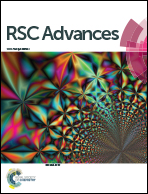Parallel motif triplex formation via a new, bi-directional hydrogen bonding pattern incorporating a synthetic cyanuryl nucleoside into the sense chain†
Abstract
This research presents the first example of the formation of a triplex via hydrogen bonding of a synthetic cyanuryl nucleoside (Cn) composed of a 6-membered ring compound (triazine-2,4,6-trione) which functions as a pyrimidine base. The Cn was able to form the triad via hydrogen bonding in two directions with two adenines, one in the antisense and one in the parallel chain. The thermal stability of the duplex between the antisense and sense chains was evaluated via its UV melting temperature. The melting curves of triplexes possessing the cyanuryl nucleoside (sense chain) and two adenines (antisense and parallel chains) were biphasic. To prove the formation of hydrogen bonding between the cyanuryl nucleoside and the adenine base toward the major groove, structural analysis via NMR was undertaken. A cyanuryl nucleoside containing three 15N in triazine-2,4,6-trione was synthesized first, and then the 15N cyanuryl nucleoside was incorporated into target sequences. The triplex containing the A·Cn![[double bond, length as m-dash]](https://www.rsc.org/images/entities/char_e001.gif) A triad was analyzed via 1H NMR, coupled and decoupled with 15N. This triad has two imino proton signals derived from the cyanuryl nucleoside, split according to the 15N coupling condition, at low field. These results are evidence of the formation of hydrogen bonds between the Cn and adenosine. The solution structure of the triplex was analyzed via NOE information from the imino proton. The cyanuryl nucleoside-containing triplex forms a right-handed helical structure similar to natural triplex DNA, albeit DNA having an enhanced pyrimidine analog in the sense chain capable of bidirectional hydrogen bonding with high sequence selectivity.
A triad was analyzed via 1H NMR, coupled and decoupled with 15N. This triad has two imino proton signals derived from the cyanuryl nucleoside, split according to the 15N coupling condition, at low field. These results are evidence of the formation of hydrogen bonds between the Cn and adenosine. The solution structure of the triplex was analyzed via NOE information from the imino proton. The cyanuryl nucleoside-containing triplex forms a right-handed helical structure similar to natural triplex DNA, albeit DNA having an enhanced pyrimidine analog in the sense chain capable of bidirectional hydrogen bonding with high sequence selectivity.



 Please wait while we load your content...
Please wait while we load your content...